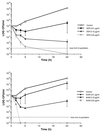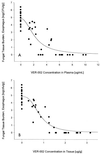Dosage-dependent antifungal efficacy of V-echinocandin (LY303366) against experimental fluconazole-resistant oropharyngeal and esophageal candidiasis
- PMID: 11158743
- PMCID: PMC90315
- DOI: 10.1128/AAC.45.2.471-479.2001
Dosage-dependent antifungal efficacy of V-echinocandin (LY303366) against experimental fluconazole-resistant oropharyngeal and esophageal candidiasis
Abstract
V-echinocandin (VER-002; LY303366) is a semisynthetic derivative of echinocandin B and a potent inhibitor of fungal (1, 3)-beta-D-glucan synthase. We studied the antifungal efficacy, the concentrations in saliva and tissue, and the safety of VER-002 at escalating dosages against experimental oropharyngeal and esophageal candidiasis caused by fluconazole-resistant Candida albicans in immunocompromised rabbits. Study groups consisted of untreated controls, animals treated with VER-002 at 1, 2.5, and 5 mg/kg of body weight/day intravenously (i.v.), animals treated with fluconazole at 2 mg/kg/day i.v., or animals treated with amphotericin B at 0.3 mg/kg/day. VER-002-treated animals showed a significant dosage-dependent clearance of C. albicans from the tongue, oropharynx, esophagus, stomach, and duodenum in comparison to that for untreated controls. VER-002 also was superior to amphotericin B and fluconazole in clearing the organism from all sites studied. These in vivo findings are consistent with the results of in vitro time-kill assays, which demonstrated that VER-002 has concentration-dependent fungicidal activity. Esophageal tissue VER-002 concentrations were dosage proportional and exceeded the MIC at all dosages. Echinocandin concentrations in saliva were greater than or equal to the MICs at all dosages. There was no elevation of serum hepatic transaminase, alkaline phosphatase, bilirubin, potassium, or creatinine levels in VER-002-treated rabbits. In summary, the echinocandin VER-002 was well tolerated, penetrated the esophagus and salivary glands, and demonstrated dosage-dependent antifungal activity against fluconazole-resistant esophageal candidiasis in immunocompromised rabbits.
Figures




Similar articles
-
Antifungal activity of LY303366, a novel echinocandin B, in experimental disseminated candidiasis in rabbits.Antimicrob Agents Chemother. 1999 Sep;43(9):2148-55. doi: 10.1128/AAC.43.9.2148. Antimicrob Agents Chemother. 1999. PMID: 10471556 Free PMC article.
-
Efficacy of PLD-118, a novel inhibitor of candida isoleucyl-tRNA synthetase, against experimental oropharyngeal and esophageal candidiasis caused by fluconazole-resistant C. albicans.Antimicrob Agents Chemother. 2004 Oct;48(10):3959-67. doi: 10.1128/AAC.48.10.3959-3967.2004. Antimicrob Agents Chemother. 2004. PMID: 15388459 Free PMC article.
-
Correlation between in vitro and in vivo antifungal activities in experimental fluconazole-resistant oropharyngeal and esophageal candidiasis.J Clin Microbiol. 2000 Jun;38(6):2369-73. doi: 10.1128/JCM.38.6.2369-2373.2000. J Clin Microbiol. 2000. PMID: 10835005 Free PMC article.
-
Micafungin: a new echinocandin antifungal.Pharmacotherapy. 2007 Jan;27(1):53-67. doi: 10.1592/phco.27.1.53. Pharmacotherapy. 2007. PMID: 17192162 Review.
-
Anidulafungin: a new echinocandin with a novel profile.Clin Ther. 2005 Jun;27(6):657-73. doi: 10.1016/j.clinthera.2005.06.010. Clin Ther. 2005. PMID: 16117974 Review.
Cited by
-
Safety and pharmacokinetics of multiple-dose anidulafungin in infants and neonates.Clin Pharmacol Ther. 2011 May;89(5):702-7. doi: 10.1038/clpt.2011.26. Epub 2011 Mar 16. Clin Pharmacol Ther. 2011. PMID: 21412233 Free PMC article.
-
Clinical pharmacodynamic index identification for micafungin in esophageal candidiasis: dosing strategy optimization.Antimicrob Agents Chemother. 2013 Nov;57(11):5714-6. doi: 10.1128/AAC.01057-13. Epub 2013 Aug 19. Antimicrob Agents Chemother. 2013. PMID: 23959319 Free PMC article. Clinical Trial.
-
Antifungal pharmacokinetics and pharmacodynamics.Cold Spring Harb Perspect Med. 2014 Nov 10;5(5):a019653. doi: 10.1101/cshperspect.a019653. Cold Spring Harb Perspect Med. 2014. PMID: 25384765 Free PMC article. Review.
-
Safety and pharmacokinetics of intravenous anidulafungin in children with neutropenia at high risk for invasive fungal infections.Antimicrob Agents Chemother. 2006 Feb;50(2):632-8. doi: 10.1128/AAC.50.2.632-638.2006. Antimicrob Agents Chemother. 2006. PMID: 16436720 Free PMC article.
-
Tissue penetration of antifungal agents.Clin Microbiol Rev. 2014 Jan;27(1):68-88. doi: 10.1128/CMR.00046-13. Clin Microbiol Rev. 2014. PMID: 24396137 Free PMC article. Review.
References
-
- Barbaro G, Barbarini G, Calderon W, Grisorio B, Alcini P, Di Lorenzo G. Fluconazole versus itraconazole for Candida esophagitis in acquired immunodeficiency syndrome. Gastroenterology. 1996;111:1169–1177. - PubMed
-
- Brassinne C, Laduron C, Coune A, Sculier J P, Hollaert C, Collette N, Meunier F. High-performance liquid chromatographic determination of amphotericin B in human serum. J Chromatogr. 1987;7:401–407. - PubMed
-
- Chiou C C, Groll A H, Gonzalez C E, Callender D, Venzon D, Pizzo P A, Wood L, Walsh T J. Esophageal candidiasis in pediatric acquired immunodeficiency syndrome: clinical manifestations and risk factors. Pediatr Infect Dis J. 2000;19:729–734. - PubMed
-
- Committee on the Care and Use of Laboratory Animals of the Institute of Laboratory Animal Resources, Commission on Life Sciences, National Research Council. Guide for the care and use of laboratory animals. Washington, D.C.: National Academy Press; 1996.
MeSH terms
Substances
LinkOut - more resources
Full Text Sources
Medical

